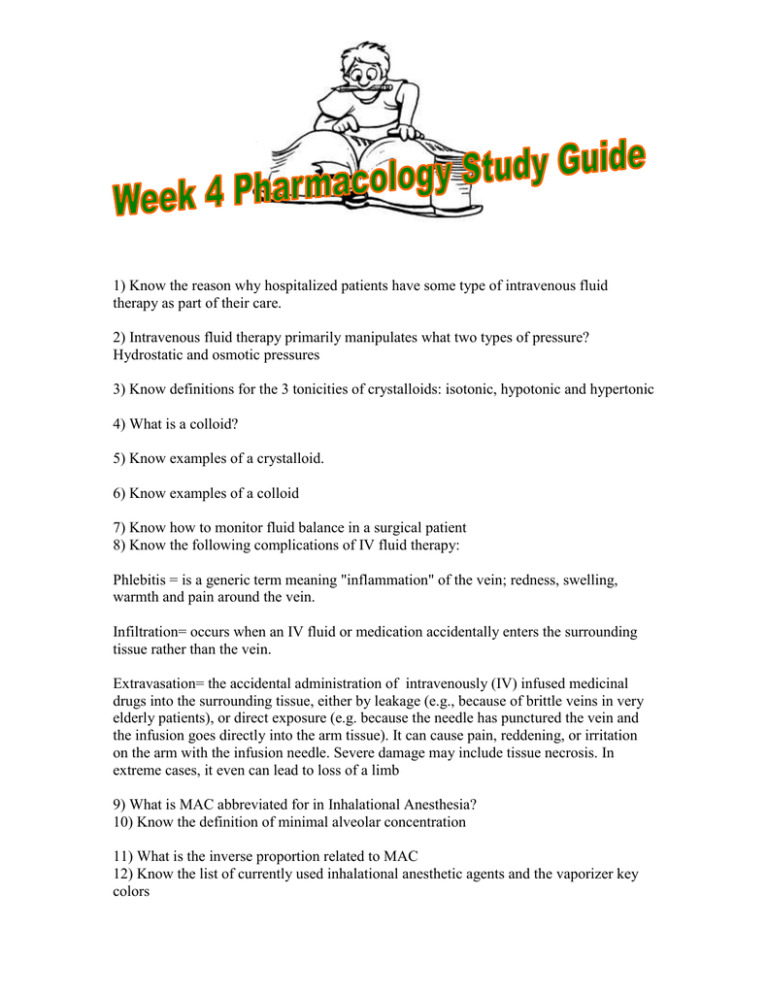1) Know the reason why hospitalized patients have some type... therapy as part of their care.
advertisement

1) Know the reason why hospitalized patients have some type of intravenous fluid therapy as part of their care. 2) Intravenous fluid therapy primarily manipulates what two types of pressure? Hydrostatic and osmotic pressures 3) Know definitions for the 3 tonicities of crystalloids: isotonic, hypotonic and hypertonic 4) What is a colloid? 5) Know examples of a crystalloid. 6) Know examples of a colloid 7) Know how to monitor fluid balance in a surgical patient 8) Know the following complications of IV fluid therapy: Phlebitis = is a generic term meaning "inflammation" of the vein; redness, swelling, warmth and pain around the vein. Infiltration= occurs when an IV fluid or medication accidentally enters the surrounding tissue rather than the vein. Extravasation= the accidental administration of intravenously (IV) infused medicinal drugs into the surrounding tissue, either by leakage (e.g., because of brittle veins in very elderly patients), or direct exposure (e.g. because the needle has punctured the vein and the infusion goes directly into the arm tissue). It can cause pain, reddening, or irritation on the arm with the infusion needle. Severe damage may include tissue necrosis. In extreme cases, it even can lead to loss of a limb 9) What is MAC abbreviated for in Inhalational Anesthesia? 10) Know the definition of minimal alveolar concentration 11) What is the inverse proportion related to MAC 12) Know the list of currently used inhalational anesthetic agents and the vaporizer key colors 13) Know which inhaled anesthetics trigger malignant hyperthermia 14) Know which inhaled anesthetic has to be heated to use during surgery 15) Know which inhaled anesthetics are used in pediatric anesthesia 16) Know the most commonly used IV non-opioid anesthetics 18) Know the definition of inhalational anesthetics 19) Know the definition of local anesthetics 20) List examples of local anesthetics 21) Know what suffix the local anesthetic names have 22) Know the 2 types of local anesthetics 23) What kind of local anesthetic agent is used during intrathecal (brain or spinal cord) injections? 24) Know what the action of epinephrine is in local anesthetics 25) Know examples of local anesthetics that may contain epinephrine. 26) Know the importance of warming intravenous fluids 27) Name examples of fluid warming devices used in the operating room 28) Know the following information: Anesthesia, or anaesthesia (see spelling differences; from Greek αν-, an-, "without"; and αἴσθησις, aisthēsis, "sensation"), traditionally meant the condition of having sensation (including the feeling of pain) blocked or temporarily taken away. Anesthesia= is a pharmacologically induced and reversible state of amnesia, analgesia, loss of responsiveness, loss of skeletal muscle reflexes or decreased stress response, or all simultaneously. This allows patients to undergo surgery and other procedures without the distress and pain they would otherwise experience. An alternative definition is a "reversible lack of awareness," including a total lack of awareness (e.g. a general anesthetic) or a lack of awareness of a part of the body such as a spinal anesthetic. The pre-existing word anesthesia was suggested by Oliver Wendell Holmes, Sr. in 1846 as a word to use to describe this state. Types of anesthesia include: local anesthesia, regional anesthesia, general anesthesia, and dissociative anesthesia. Local anesthesia inhibits sensory perception within a specific location on the body, such as a tooth or the urinary bladder. Regional anesthesia renders a larger area of the body insensate by blocking transmission of nerve impulses between a part of the body and the spinal cord. Two frequently used types of regional anesthesia are spinal anesthesia and epidural anesthesia. General anesthesia refers to inhibition of sensory, motor and sympathetic nerve transmission at the level of the brain, resulting in unconsciousness and lack of sensation. Dissociative anesthesia uses agents that inhibit transmission of nerve impulses between higher centers of the brain (such as the cerebral cortex) and the lower centers, such as those found within the limbic system.




